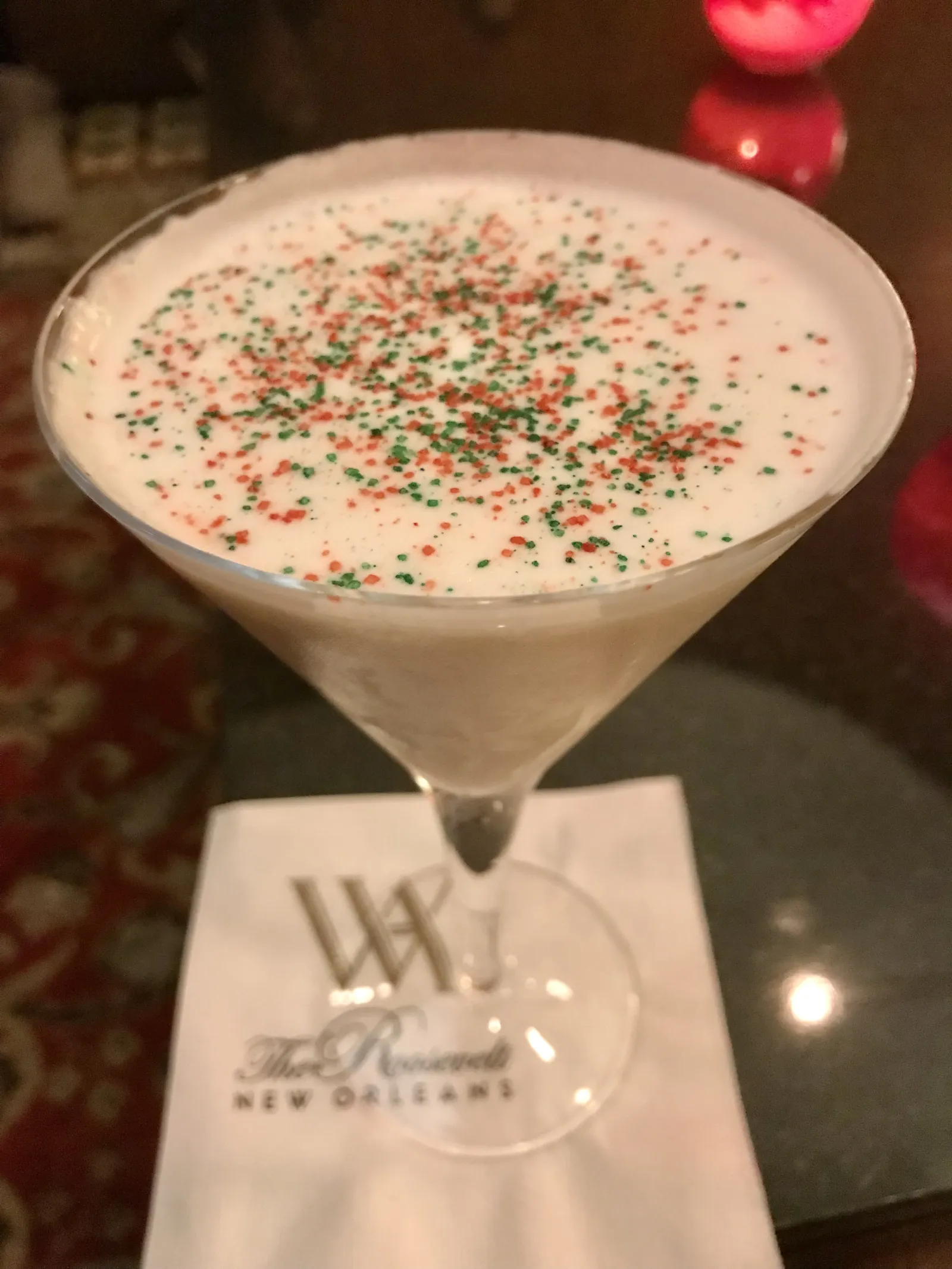Christmas is all about traditions. During the holidays, there are certain rituals that we repeat every year. We deck the halls. We hang the stockings with care. Santa Claus comes to town. There are even some people out there who know what wassailing is.
Of course, not everyone celebrates Christmas in quite the same way, and in Louisiana, we have our own special set of holiday traditions. There's Père Noël and lights at the Roosevelt, eggnog daiquiris and oyster dressing, Bingle and bonfires. It's too hot outside to dash through the snow. Grandma's more likely to be run over by a streetcar. Flaming rum in Bananas Foster is our idea of making spirits bright. And many Louisianans look at Christmas as merely a stepping stone to crawfish season and Mardi Gras.
Here's a look at several Louisiana holiday traditions and how they came to be.

Roux Awakening
Back in the 18th century, the French had a habit of eating foie gras and oysters after midnight and gorging themselves on up to 13 desserts before the sun came up. These late-night food fests on Christmas Eve were extravagant dinners comprised of a range of rich foods. Religious in origins, this overeating practice came about because Catholics would fast all of Christmas Eve Day to honor the birth of the baby Jesus. But Catholics can be just as hungry as they are devout, so as soon as they got out of midnight mass, it was time to indulge. Their ritualized face-stuffing became known as réveillon, which roughly translates to "awakening," because they had to stay awake most of the night in order to shovel all that food in.
Like many other French traditions, réveillon made its way to New Orleans. In the 1800s, fasting New Orleanians sat in Christmas Eve church services, stomachs rumbling during the quiet parts, while visions of their forthcoming gumbo danced in their heads. Even if you were the type to fall asleep during the sermon, réveillon dinner was a meal worth waking up for.
Nowadays, réveillon is a New Orleans dining-out tradition involving multiple gluttonous courses served in rapid succession, often for under 50 bucks. The entire month of December, many New Orleans restaurants offer réveillon prix fixe menus, where the approximate number of calories consumed is only exceeded by the number of locals who partake. And you don't have to wait until after midnight mass to get one of these meals—in fact, you'll need to get your réveillon dinners during regular restaurant hours. But if you really have your heart set on eating during the wee hours, you can always warm up your leftovers.
Birds of a Feather
Roast Together
Another local tradition is that of eating turducken: that beloved turkey/duck/chicken trifecta that graces many a Louisiana table during the holidays. This triple stack of poultry goodness is made up of three birds nesting, one inside the other. Sometimes three's a crowd.
The turducken is a chicken stuffed inside a duck that's been crammed inside a turkey. Talk about a strange bird. The entire birdy conglomerate is then cooked, served, and eaten as a single fusion of fowl—but it's guaranteed to be three times the fun. The animal layering process that produces such unusual meat hybrids is known as engastration.
A little bird told us that the late chef Paul Prudhomme is credited with creating the original potpourri of poultry. He killed three delicious birds with one stone in more ways than one when he invented this white-meat triptych, trademarked its name in 1986, and forever earned Louisiana renown as the birthplace of the world-famous turducken.
Now, just in time for the holidays, get your ducks in a row—or pack them with a chicken and shove them into a turkey—cook a turducken, and your friends and family will flock to the table.

Playing With Fire
In St. James Parish every Christmas Eve, the levees are all lit up like a Christmas tree. For miles along the Mississippi River, as many as 200 bonfires burn while people gather round, eat gumbo, guzzle eggnog, and hold fireside chats. Depending on who you ask, the bonfires are meant to light the way for either Papa Noël, the passing riverboats, or Christians on their way to midnight mass.
This Louisiana Christmas tradition most likely came over with the French and German immigrants who first settled in Louisiana. It dates back thousands of years to the Celts who lived in Europe long before there was even a Christ in Christmas. During the winter and summer solstices, they'd build giant bonfires to worship the sun in the hopes of prolonging their crop-growing seasons. The Christmas Yule log is a vestige of these winter solstice fires of long ago.
Over a century ago, people first began making these bonfires in Louisiana by burning anything they had on hand, such as used shipping crates, scrap wood, and old tires. But they soon came under fire for polluting the environment, and now no one's burning rubber anymore. These days, they cut willow logs and branches with chainsaws, neatly stack them into a pyramid shape covered with cane reeds from the river, add fuel to the fire—diesel is the combustible of choice—and watch it burn. Some people choose to branch out with their branches and make creatively shaped bonfires, formed like such things as airplanes and alligators. It takes as much as a month to complete construction of one of these fiery creations.
In recent years, bonfires have become the hottest thing to do at Christmas, and there's even a bonfire festival in Lutcher. Everyone gets really fired up about these festivities, and thousands come from all over the world just to see the famous bonfires. In one year alone, approximately 40,000 people came out, drawn like moths to the flames.

Going Toe-to-Toe
If Santa checks his Nice List twice and discovers that certain boys and girls have been naughty and don't make the cut, the worst they risk is foregoing the Lego set of their dreams or, in exceptional cases, awakening to a stocking full of coal.
In Louisiana Cajun and Creole cultures, however, the stakes are considerably higher. This is because Madame Grands Doigts, or "Madam Long Fingers," arrives on New Year's Eve. For the good kids, she leaves fruit, candy, trinkets, or coins, either in their stockings or in their shoes, which have been purposely left out for her arrival. She makes use of her long, boney fingers to shove goodies all the way to the very end of the good children's shoes—thus giving new meaning to the expression "goodie two shoes."
But woe to the children who have misbehaved. Madame Grands Doigts uses those boney fingers to pinch their toes (sometimes pulling them right off), grab them by the scruff of the neck, or stuff them in her sack. She might even eat them. Some people believe that Madame Grands Doigts wears a fashionable necklace of little children's dismembered toes around her neck. It's enough to scare the Cajun children into virtuousness all year round. They'd better be good, for goodness' sake.
In some Cajun communities, it's not Madame Grands Doigts who comes to visit New Year's Eve, but someone known as La Christine. She likewise leaves small goodies and sweets, but minus the toe-snatching and sack o' naughty children.
La Christine is most likely a custom that the Cajuns adapted long ago from German settlers in Louisiana, a variation of the German word Christkind, meaning Christ Child. Initially, Christkind brought gifts to German children on Christmas Eve, an early version of today's Santa Claus and possibly where our term "Kris Kringle" comes from.
Other traditional New Year's Eve visitors to Cajun and Creole households include Le Petit Bonhomme Janvier, or "The Little January Man," and Papa l'An, or "Father Year." Like the others, he showers good little boys and girls with trinkets, candies, and even fireworks. And for the bad kids, he's known to steal back their previously delivered Christmas gifts to return them to Santa. Or Amazon.

